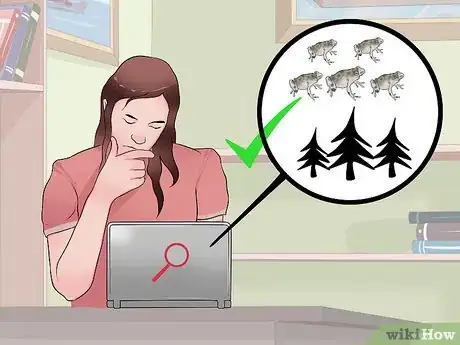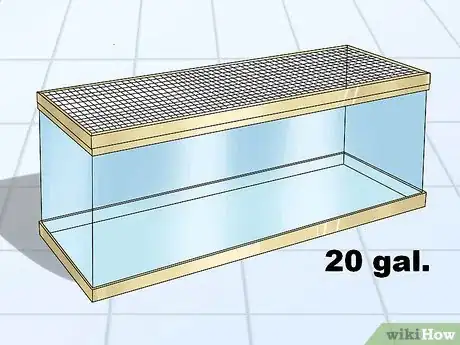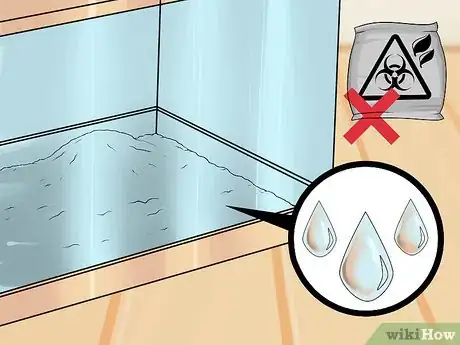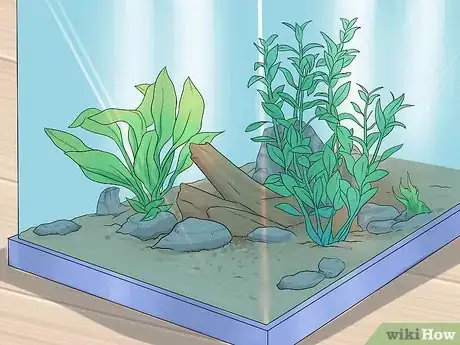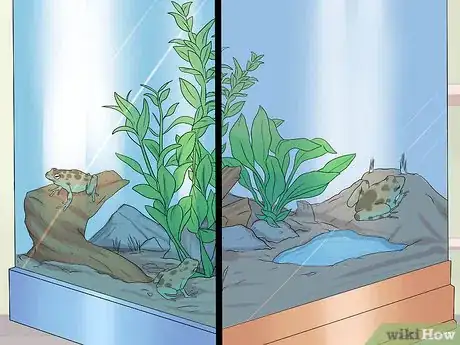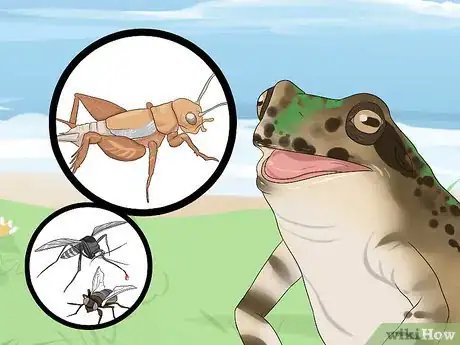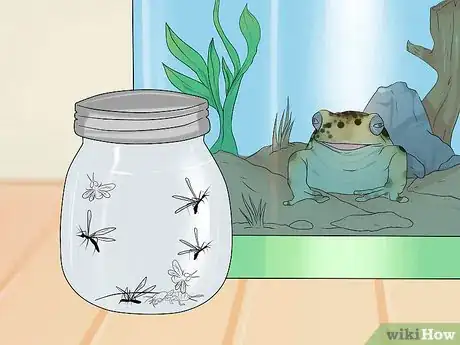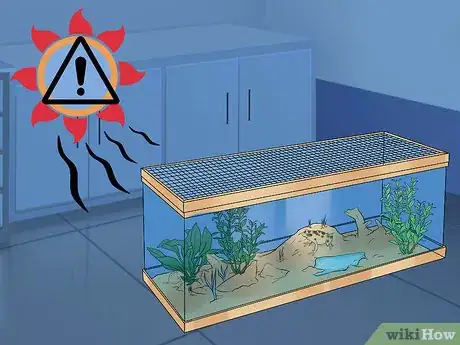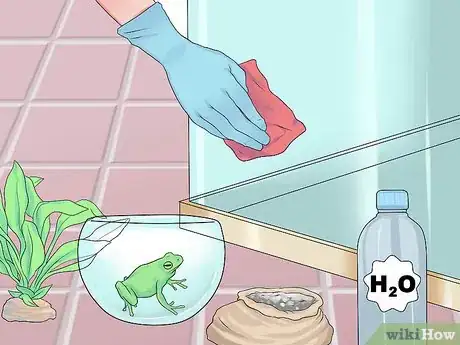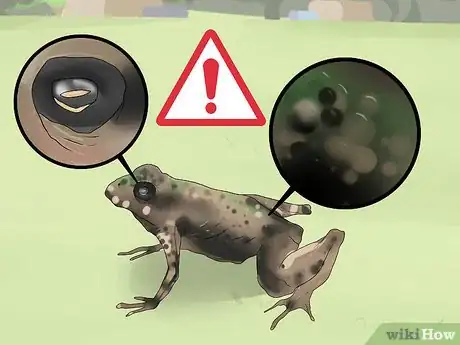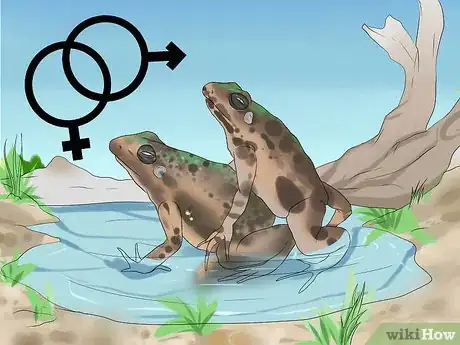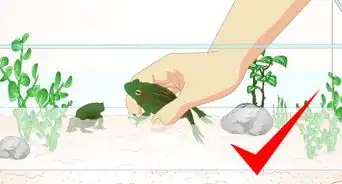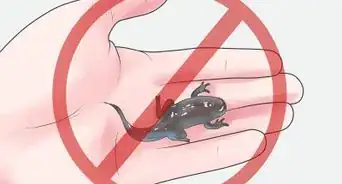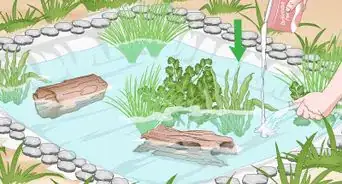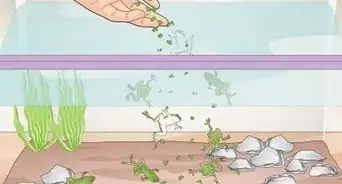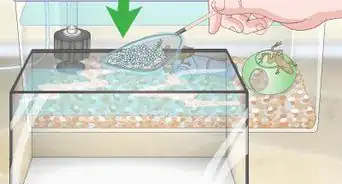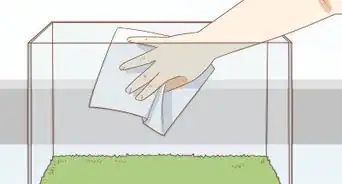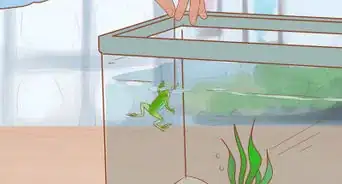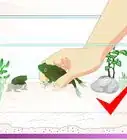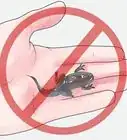This article was co-authored by Pippa Elliott, MRCVS. Dr. Elliott, BVMS, MRCVS is a veterinarian with over 30 years of experience in veterinary surgery and companion animal practice. She graduated from the University of Glasgow in 1987 with a degree in veterinary medicine and surgery. She has worked at the same animal clinic in her hometown for over 20 years.
There are 11 references cited in this article, which can be found at the bottom of the page.
This article has been viewed 28,001 times.
Northern cricket frogs make good pets, as they do not grow very large and are easy to catch. But, like any pet, they require a specific diet and environment to thrive in captivity. If you are considering getting a northern cricket frog as a pet, make sure you are prepared to properly care for it.
Steps
Building a Safe and Comfortable Enclosure
-
1Make sure it is legal to catch and keep northern cricket frogs in your area. Since these frogs are endangered in some areas of the United States, it may not be a good idea to catch one and take it from its natural habitat.[1]
- Currently, the populations of this species are increasing and stable. Make sure you do a search to find out the population levels of this frog in your area, and determine if it is safe and allowed to catch them.
- Alternatively, you might consider making your own backyard a better environment for the frogs. If the population is still recovering in your area, you can help rebuild it by enriching its natural habitat. Avoid using fertilizer, and avoid cutting down vegetation surrounding any natural water sources in your vicinity.
-
2Get a large enclosure. Even though these frogs don’t need a lot of height, they do need a good amount of width and length in their tank or aquarium.
- Most frogs do well in a 20 gallon tank, so check your local pet store for a tank this size or larger. This will allow the frog enough space to thrive.[2]
- Make sure you have a lid on your enclosure. Use a soft screen lid. This will allow air to flow into the tank, while keeping the frog inside and safe.[3]
- Northern cricket frogs are non-climbing frogs, so they do not need branches in their enclosure to climb on, and the enclosure does not need much height.[4]
Advertisement -
3Use moist soil to line the bottom of the enclosure. Since these frogs normally inhabit areas near lakes, streams, ponds, and other water sources, they need moisture to thrive.[5]
- Create a slight slope with the soil in the bottom of the enclosure. These frogs live on the banks of water sources, so having a slope will make the enclosure more similar to their natural habitats.[6]
- Use organic soil without any chemicals or fertilizers in it. You want to make sure it is as close to the frog’s natural habitat as possible. You can also use pine bark that is easily found at any garden supply store.[7]
-
4Decorate the enclosure with plants. Use these plants to create a canopy in the enclosure. In the wild, northern cricket frogs live in areas with canopies created by vegetation, along the banks of different water sources.[8]
- You can use artificial or plastic plants. You can buy these at most pet stores in the aquarium section. You can also get small hollowed out logs or rocks for your frog to hide inside of.[9]
- The canopy can partially or completely cover the enclosure, but you might consider leaving some areas for light to peek through to the bottom.
-
5Put water in the enclosure. You can use a water dish or simply place water at the bottom of the slope you created with the soil. This will recreate the natural habitat of the northern cricket frog. Use clean, filtered water.
- You can buy a kit that will separate your tank into two parts—land and water. This will allow you to use an automatic filter in the water.
- Cleaning a frog’s tank is a lot like cleaning a fish tank, but you might have to do it more often because frogs tend to shed pretty often. A water filter will help keep the water clean between actual tank cleanings.
- Regardless of how you incorporate the water, make sure there is enough of it to allow the frog to keep himself wet as needed.
-
6House different species of frogs in different tanks. If you have a different species of frog already and want to get a northern cricket frog, give the new frog his own enclosure.[10]
- You can house multiples of the same species in the same tank, but don’t overcrowd your tank. Keep only two or three frogs in any one 20 gallon enclosure.
- If you choose to keep different species in the same tank, make sure the other species you choose require the same environment as the northern cricket frog. You will want to choose a species that does not need too much height, and enjoys a damp environment.
Feeding Your Frog
-
1Learn what to feed your frog. The primary diet of northern cricket frogs is insects, particularly mosquitoes.[11] But, as a rule of thumb, most frogs will eat and enjoy crickets as a meal.
- These frogs will also eat an abundant amount of different species of water bugs and arthropods. They are generally opportunistic in what they eat, and since they dwell near fresh water sources, they will eat whatever is present in their habitat.
- You could even keep some earthworms in the moist soil in the frog’s enclosure to allow the frog to eat those.
-
2Feed your frog live food. Northern cricket frogs and most other frog species feed almost entirely on living, moving prey that they have to catch to eat. If the prey is dead or not moving, they may overlook it entirely.
- If your frog doesn’t seem interested in the live food at first, he may just not be hungry. Leave the food in the enclosure and the frog will eat it eventually, when he wants it.
-
3Feed your frog at least once a day. You may need to feed your frog more or less than this, depending on their appetite and how fast they eat what you give them. This may take some guessing and testing at first.
- Since you will likely be putting live insects into the enclosure for your frog to eat, it may take a little while for your frog to find and eat the prey.
- Every frog will have different feeding behaviors. Just watch your frog during each feeding session and evaluate his needs. Start with 2 or 3 insects first, then see how fast they eat them. Deciding how much and how often to feed your frog will take some time and evaluation of your frog’s feeding habits.[12]
-
4Maintain a steady supply of food. You can catch insects on your own, or go to a pet store to purchase insects for it to eat. Since this frog is particularly small, you will want to make sure you buy or catch very small insects for it to eat.
- You can use a net to catch insects like mosquitoes and keep them in a jar with a few tiny air holes poked in the top.
- When you purchase insects from the pet store, they will come in a container that you can keep them in until you are ready to feed your frog. Or, you can make your own container to use and reuse to house your frog’s food. Just use a thumbtack to poke air holes in a small plastic container, to allow air in but not allow bugs out.[13]
Caring For Your Frog
-
1Maintain a warm, moist environment in the enclosure. You want to make sure your frog feels at home in its enclosure. This means maintaining the vegetation, soil, and water.
- Use a spray bottle to wet the enclosure a few times a day. This frog lives in naturally damp and moist environments, so a spray bottle can help maintain this level of moisture.[14]
- You can buy a product called vermiculite which retains water and slowly releases it over time. This will help keep your tank’s humidity and moisture level more stable.
- Your frog will need high humidity in its enclosure. The misting will help with this, but make sure to keep the enclosure relatively warm to aid in keeping the humidity level stable.
- These frogs exist in the wild in many different climates, but keeping your enclosure between 75 and 80 degrees fahrenheit will keep him the most comfortable.
-
2Avoid keeping a bright light on the enclosure. Even if your enclosure is properly outfitted with a canopy of vegetation, these frogs are more likely to be active in lower light. Too much bright light could also be damaging to their vision.
- Don’t put your tank in too much direct sunlight. This will cause algae to grow more rapidly and you will have to clean the tank more often.[15]
- In the wild, these frogs are most active around dusk, when the light isn’t too bright, but it isn’t quite nighttime yet. If you want to catch one of these frogs, try looking around this time.[16]
-
3Clean the enclosure when necessary. Make sure to change out the water in the enclosure and clean the interior when it appears dirty. Like any other pet, this frog will require fresh water and a comfortable living environment.
- Remove the frog from the tank to clean it. Keep your frog in a safe container with a vented lid while you clean the tank.
- Empty the tank completely and use warm water only to clean everything in the tank, including your plastic plants. Replace the soil with new soil, and refresh the water.[17]
-
4Watch for any symptoms that your frog might be sick or injured. There are some easy to spot symptoms of sickness or injury that you should be mindful of when caring for your frog.
- Sitting totally out in the open during the daylight hours, cloudy eyes, discoloration, looking very thin, and swelling of the body are all symptoms of illness.[18]
- The best thing to help your frog recover is to seek advice from a vet, and to keep it safe and out of harm’s way while it recovers. [19]
-
5Understand the breeding habits of northern cricket frogs. If you have a male and female cricket frog in the same enclosure, they may breed. Their breeding is aquatic, meaning it will happen in the water.[20]
- If you end up with two frogs that breed, the eggs will be laid in the water. Be mindful to check for eggs before cleaning the water should you have a male and female frog in the same enclosure.[21]
- Females can lay up to 400 eggs at a time in small groups of between 2-7 eggs. Monitor how many eggs your female frog lays should you breed your frogs.[22]
Warnings
- Be careful when attempting to catch cricket frogs, as they can be fast and they may get injured.⧼thumbs_response⧽
References
- ↑ http://amphibiaweb.org/cgi/amphib_query?where-genus=Acris&where-species=crepitans
- ↑ http://allaboutfrogs.org/info/housing/halftank.html
- ↑ http://allaboutfrogs.org/info/housing/halftank.html
- ↑ http://eol.org/pages/332454/details
- ↑ http://dnr.wi.gov/files/PDF/pubs/er/ER0666.pdf
- ↑ http://dnr.wi.gov/files/PDF/pubs/er/ER0666.pdf
- ↑ http://allaboutfrogs.org/info/housing/halftank.html
- ↑ http://dnr.wi.gov/files/PDF/pubs/er/ER0666.pdf
- ↑ http://allaboutfrogs.org/info/housing/halftank.html
- ↑ http://allaboutfrogs.org/info/doctor/common.html#mix
- ↑ http://www.theanimalfiles.com/amphibians/frogs/northern_cricket_frog.html
- ↑ http://allaboutfrogs.org/info/doctor/common.html#mix
- ↑ http://allaboutfrogs.org/info/doctor/bugs.html
- ↑ http://www.iucnredlist.org/details/55286/0
- ↑ http://allaboutfrogs.org/info/housing/halftank.html
- ↑ http://dnr.wi.gov/files/PDF/pubs/er/ER0666.pdf
- ↑ http://allaboutfrogs.org/info/housing/halftank.html
- ↑ http://www.frogsafe.org.au/disease/symptoms_frog.shtml
- ↑ http://www.froglife.org/info-advice/frogs-toads-injury-illness-or-death/
- ↑ http://amphibiaweb.org/cgi/amphib_query?where-genus=Acris&where-species=crepitans
- ↑ http://eol.org/pages/332454/details
- ↑ http://amphibiaweb.org/cgi/amphib_query?where-genus=Acris&where-species=crepitans
- ↑ https://www.vetbabble.com/small-pets/frog-care-guide/
About This Article
To care for northern cricket frogs, start by getting a 20-gallon aquarium with a soft screen lid and lining it with moist, organic soil. Next, place the tank in a low-lit area so that it's never exposed to direct sunlight. Use a spray bottle to wet the inside of the tank a few times a day to maintain comfortable humidity and moisture levels. Also, try to maintain a temperature between 75 to 80 degrees Fahrenheit, which is preferred by cricket frogs. Finally, keep a clean dish of water in the aquarium at all times and remember to feed your frog live insects at least once daily! For more tips from our Veterinary co-author on feeding northern cricket frogs, read on!
